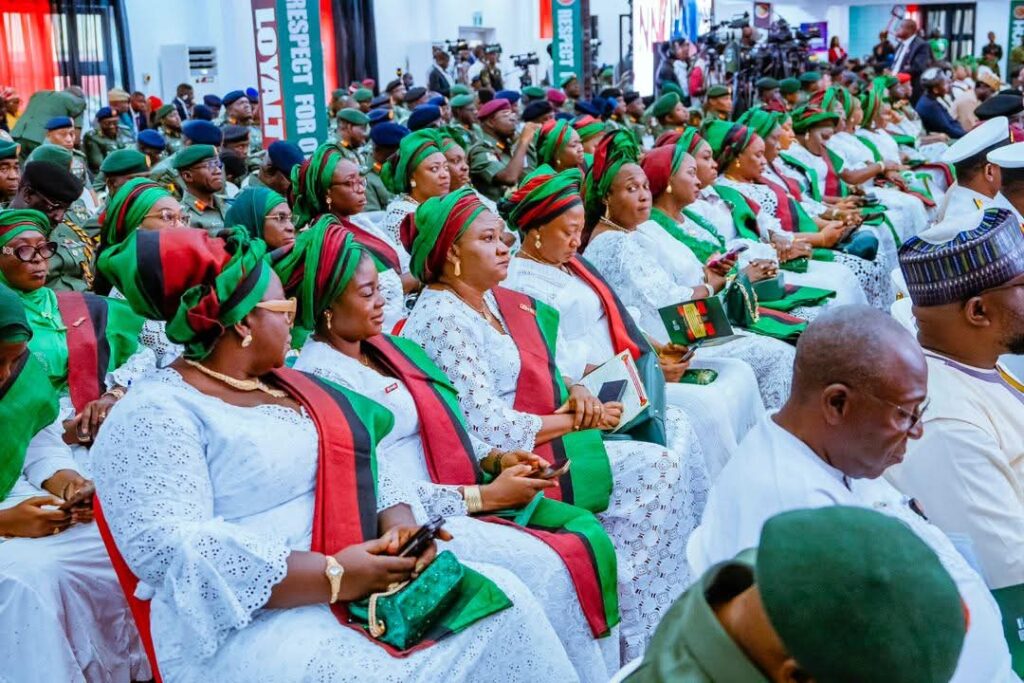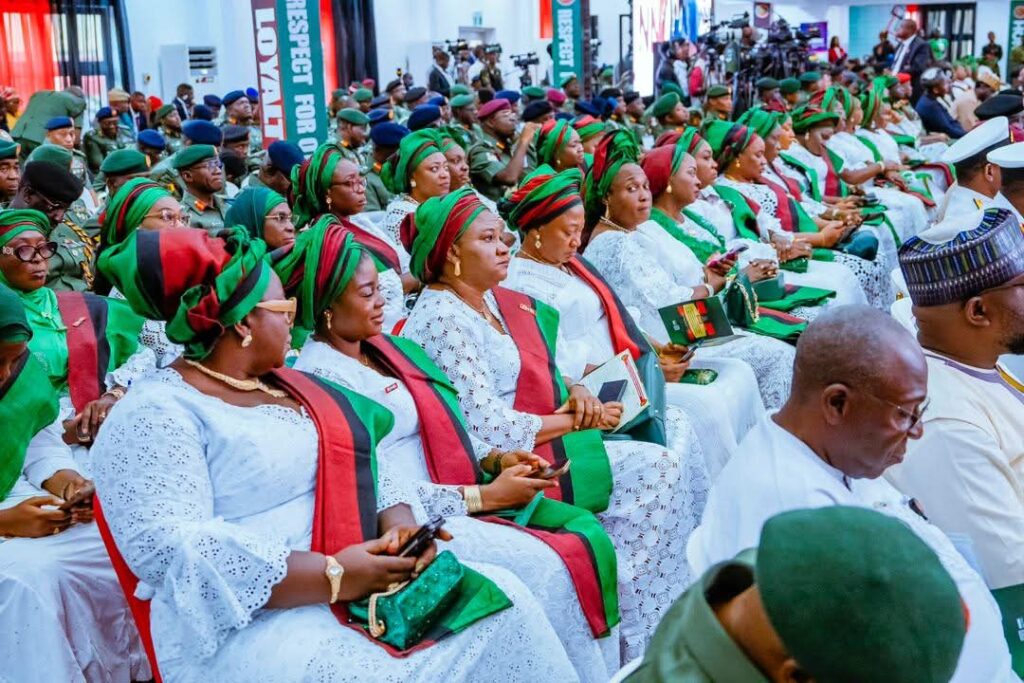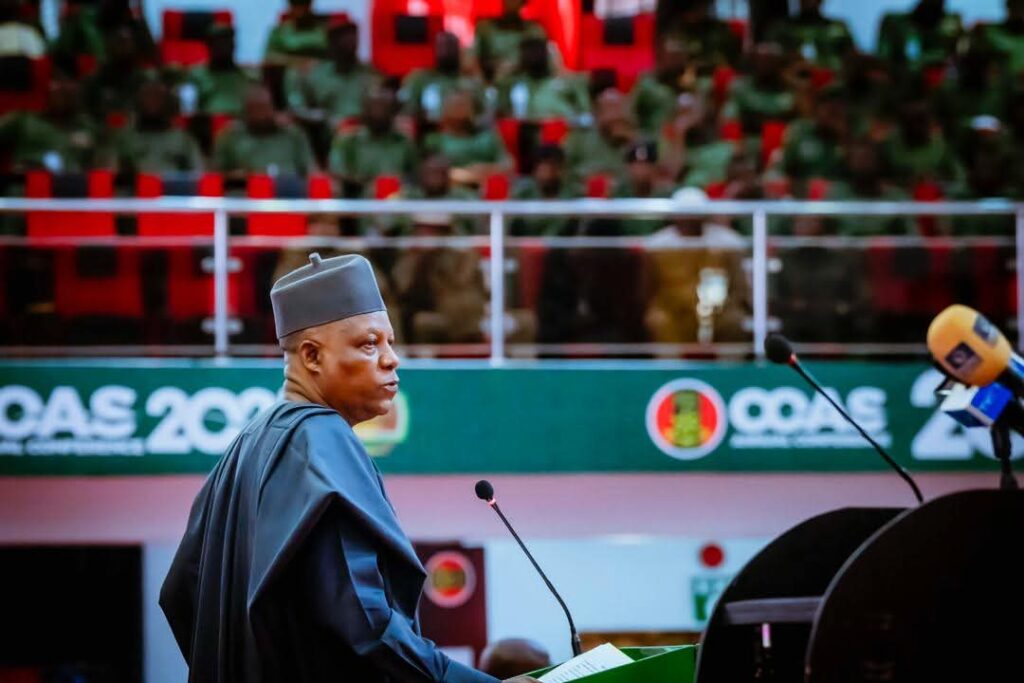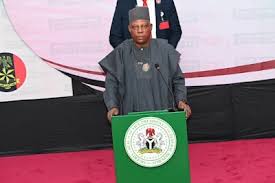News
Riot Erupts at Efab Bridge Following Alleged Killing by FCT Task Force

Riot Erupts at Efab Bridge Following Alleged Killing by FCT Task Force
By: Zagazola Makama
A riot broke out on Tuesday morning around Efab Bridge along the Kubwa-Gwarinpa Expressway following the alleged killing of an individual by the FCT Task Force Enforcement Team.
Police sources told Zagazola Makama that the incident occurred around 10:20 AM when officers of the Galadima Division received a distress call regarding a violent disturbance in the area.
The sources said that upon arrival, police patrol teams, alongside the Commander of the Rapid Response Squad (RRS) and the Assistant Commissioner of Police (ACPol) Kubwa, found a chaotic scene with an enraged crowd protesting the alleged fatal shooting.
Tensions escalated when a Civil Defence officer stationed on top of the bridge fired warning shots into the air, further provoking the already agitated crowd. Protesters, including commercial motorcyclists (Okada riders), responded by throwing stones and other objects at the police.
During the altercation, Inspector Victor Gabriel of the Galadima Division sustained a severe head injury and was promptly evacuated to Royal Care Hospital in Gwarinpa for treatment.
Police authorities confirmed that two bodies, believed to be those of Okada riders, have been deposited at the Kubwa General Hospital, while one injured victim is receiving medical attention at the same facility. Nine motorcycles were also recovered from the scene.
In a bid to restore calm, the Commissioner of Police met with relatives of the deceased and Okada leadership, assuring them that justice would be served. Meanwhile, an armed squad, comprising police and Civil Defence operatives involved in the incident, is undergoing interrogation at the State Criminal Investigation Department (SCID).
Security patrols and confidence-building measures are currently in place to prevent further unrest.
Riot Erupts at Efab Bridge Following Alleged Killing by FCT Task Force
News
President Tinubu: We’re Mobilising All Military Assets To Protect Nigerians, Crush Security Threats

President Tinubu: We’re Mobilising All Military Assets To Protect Nigerians, Crush Security Threats
** Procures mine-resistant vehicles, new armoured fleet for armed forces modernisation
** Charges troops on discipline, professionalism, adherence to constitutional order
By: Our Reporter
President Bola Ahmed Tinubu has restated his administration’s firm resolve to mobilise all military and law enforcement assets to crush security threats and protect the lives all citizens of Nigeria.
Accordingly, he announced the procurement of mine-resistant ambush-protected vehicles and a new armoured fleet for the military, as well as the refurbishment of over 100 Armoured Fighting Vehicles for return to active service.
President Tinubu disclosed this in Ojuelegba, Lagos State, on Monday when he declared open the Chief of Army Staff Annual Conference 2025.
Speaking at Nebo Hall, Abalti Barracks, venue of the conference, the President who was represented by his deputy, Vice President Kashim Shettima, reaffirmed that security remains a central pillar of his administration’s Renewed Hope Agenda.
“There is no nation that can achieve greatness without security. This government remains resolute in mobilising all military and law enforcement assets to eliminate security threats and protect the lives and property of all Nigerians,” he said.

The Nigerian leader noted that his administration is firmly committed to the modernisation of the Armed Forces through improved training, modern equipment and enhanced operational capacity.
He said beyond the recent induction of helicopters into Nigerian Army Aviation and the training of pilots, the government has advanced the procurement of additional Mine Resistant Ambush Protected Vehicles, Armoured Vehicles and Patrol Vehicles to boost troop protection and battlefield effectiveness.
His words: “Following the induction of helicopters into Nigerian Army Aviation and the training of pilots, we have advanced the procurement of additional Mine Resistant Ambush Protected Vehicles, Armoured Vehicles, and Patrol Vehicles.

“We have also refurbished over one hundred Armoured Fighting Vehicles, now returned to active service. These efforts reflect our clear commitment to strengthening the Nigerian Army’s operational readiness.”
He added that the Federal Government is deepening partnerships with friendly nations to promote research, innovation and indigenous defence production, with the long-term goal of achieving self-reliance in defence and security.
Commending the Nigerian Army for what he described as impressive gains in the fight against terrorism and other security challenges, President Tinubu said reports from various theatres of operation point to improved outcomes driven by professionalism, courage and effective joint operations with sister services and security agencies.
“The positive reports emerging from the various theatres of operation are encouraging and stand as testimony to your resilience and professionalism,” he said.

The President assured the military of the government’s unwavering support in fulfilling its constitutional mandate of safeguarding Nigeria’s territorial integrity, noting that security is one of the eight priority areas of his administration.
He also stressed the importance of discipline, professionalism and adherence to constitutional order, describing the apolitical posture of the Armed Forces as critical to sustaining public trust.
President Tinubu further praised the Nigerian Army’s civil-military cooperation initiatives across the country, noting that security efforts must also focus on winning hearts, restoring dignity and supporting development at the grassroots.
Paying tribute to fallen soldiers, the President said their sacrifices remain permanently etched in Nigeria’s national memory, assuring that the government will continue to support their families and improve the welfare of serving personnel in recognition of their service to the nation.

Earlier, Lagos State Governor, Babajide Sanwo-Olu, commended the Nigerian Army for its efforts in strengthening civil–military relations in the state.
He reaffirmed the commitment of the Lagos State Government to supporting the Army in the discharge of its constitutional responsibilities within the state and beyond.
In his remarks, the Minister of Defence, General Christopher Musa (rtd), confirmed the commitment of the Tinubu administration, through the Ministry of Defence, to providing continuous policy direction for the Nigerian Army.
He called on officers and commanders to remain loyal and united, stressing the need for collective support to enable the Army effectively address the country’s security challenges.
The Defence Minister also praised the officers and men currently deployed in various operations, even as he thanked Nigerians for their confidence in the Armed Forces, assuring that government would act with renewed vigour and decisiveness in tackling prevailing security threats.
In his welcome address, the Chief of Army Staff, Lieutenant General Waidi Shaibu, unveiled a range of welfare packages designed to enhance the wellbeing of officers and men of the Nigerian Army.
He explained that the welfare packages are part of deliberate efforts to boost morale and improve operational effectiveness across the Army.
The Chief of Army Staff also disclosed that President Tinubu has consistently provided the operational needs of the Nigerian Army since assuming office.

He commended the Federal Government for meeting the operational demands of the Army, urging officers, particularly commanders and personnel on special operations, to justify the confidence reposed in them.
Reviewing the Army’s achievements over the past year, General Shaibu reaffirmed the readiness of the Nigerian Army to match government’s support with decisive action against terrorism and other security threats confronting the nation.
High point of the event was unveiling of a biography of the late former Chief of Army Staff, Lieutenant General Taoreed Lagbaja, by Vice President Shettima, alongside senior military officers and other dignitaries.
The Vice President presented 15 Toyota Hilux vehicles to deserving warrant officers as part of efforts to motivate personnel and encourage excellence in service.
He also witnessed the presentation of cheques under the Nigerian Army Personnel Insurance Scheme to the families of five fallen soldiers.
The event was attended by representatives of the President of the Senate, former Defence and Army Chiefs, and traditional rulers, among others.
President Tinubu: We’re Mobilising All Military Assets To Protect Nigerians, Crush Security Threats
News
Defence Minister urges unity, actionable strategies at COAS 10th annual conference to consolidate Nigeria’s security gains

Defence Minister urges unity, actionable strategies at COAS 10th annual conference to consolidate Nigeria’s security gains
By: Zagazola Makama
The Minister of Defence, General Christopher Musa, has called for a decisive shift from discussion to action in addressing Nigeria’s complex security challenges, stressing that the country’s gains against terrorism, banditry, and other criminal networks can only be sustained through joint operations, inter-agency collaboration, and collective national effort.
Speaking at the opening ceremony of the 10th Chief of Army Staff (COAS) Annual Conference 2025 in Lagos, on Monday, General Musa described the gathering as a critical forum for assessing the operational posture, readiness, and professionalism of the Nigerian Army while aligning the service’s priorities with the nation’s strategic security objectives.
“The importance of this conference cannot be overstated,” General Musa said. “Nigeria continues to face a combination of terrorism, banditry, criminality, and other asymmetric threats that demand sustained focus, strategic clarity, and adaptive leadership. The Army, together with other security agencies and the society at large, must operate in unison to confront these threats effectively.”
The Minister highlighted that the operational capacity of terrorist groups, insurgents, and criminal networks has been significantly degraded across multiple theatres, attributing these gains to the courage and professionalism of the troops, improved planning, education, and coordinated joint operations conducted within a multi-agency framework.
“The truth of the matter is that no single service, no single individual, can achieve this alone,” he said. “Success in today’s security environment requires the whole of society working together in synergy.”
General Musa emphasized that inter-service cooperation and intelligence sharing are no longer optional but fundamental to effective national defense. He urged the Army leadership to ensure that the recommendations from the conference are implemented through concrete operational actions, stressing that strategic discussions must translate into measurable tactical outcomes.
“While we celebrate our successes, we must never lose sight of the human dimension of service,” he added, paying tribute to fallen soldiers, wounded personnel, and the families who bear the enduring cost of national service.
He commended the families of the late Lieutenant General Tariq Lagbajan and Brigadier General Oba for their sacrifices and underscored the government’s continued commitment to the welfare, medical care, and long-term support of personnel and their families.
General Musa also lauded the Chief of Army Staff, Lieutenant General Waidi Shaibu, for his professional trajectory, from battalion and brigade commands in the North East to theatre command, culminating in his appointment as the Army Chief. “Your leadership exemplifies operational excellence and a deep understanding of the challenges on the ground. The challenge before all senior commanders is to evolve new strategies to defeat the enemies of the state,” he said.
He further highlighted that security remains central to the President’s Renewed Hope Agenda and reiterated the Federal Government’s unwavering support for the Armed Forces.
According to the Defence Minister, strategic direction, policy support, and capability development provided by the Ministry of Defence will ensure that the Armed Forces remain professional, responsive, and future-ready, while reinforcing institutional accountability and operational effectiveness.
“The Nigerian Army and indeed the Armed Forces have stabilized this country and will continue to do so. We must take these security challenges as our own and contribute individually and collectively to winning this war,” General Musa stated.
The 10th COAS Annual Conference, themed “Examine the Correct Landscape of Terrorism Through the Lengths of Diplomatic and Military Action: Strategies for Long-Term Prevention and Stabilization,”brings together senior commanders, security stakeholders, and resource persons to reflect on lessons learned, examine emerging threats, and propose practical measures to enhance operational readiness and effectiveness in the year ahead.
The Defence Minister concluded by thanking Nigerians for their support and the Governor of Lagos State for hosting the conference, noting that collaborative engagement between the government, security agencies, and citizens is key to sustaining national peace, security, and stability.
Defence Minister urges unity, actionable strategies at COAS 10th annual conference to consolidate Nigeria’s security gains
News
FG pledges full support for Army modernization, welfare at COAS annual conference 2025

FG pledges full support for Army modernization, welfare at COAS annual conference 2025
By: Zagazola Makama
President Bola Ahmed Tinubu, has pledged the federal government’s unwavering support for the Nigerian Army, emphasizing modernization, operational readiness, and the welfare of personnel. The statement was made during the opening ceremony of the Chief of Army Staff (COAS) Annual Conference 2025 in Lagos on Monday.
Represented by the Vice President of the Federal Republic of Nigeria, Senator Kashim Shettima, Tinubu highlighted the critical role of the Nigerian Army in safeguarding the nation’s territorial integrity and maintaining peace amid evolving security challenges.
“There is no nation that can achieve greatness without security. The Nigerian Army has always risen to the nation’s call, and this administration remains resolute in mobilizing all military and law enforcement assets to eliminate threats and protect lives and property,” he said.
The Vice President commended the leadership of the Chief of Army Staff, Lieutenant General Waidi Shaibu and officers across all ranks for transforming the Nigerian Army into a professional, resilient, and adaptable force capable of operating decisively within joint and multi-agency frameworks.
He noted that since assuming leadership, the government had closely monitored the army’s progress in training, administration, and operations.
The conference, themed “Examining the Current Landscape of Terrorism through Diplomatic and Military Lenses: Strategy for Long-term Prevention and Stabilization”, was described as timely and critical to national security planning.
“I urge frank and constructive discussions guided by realism and experience. Lead your engagements here, produce enduring strategies that will strengthen our collective resolve to secure Nigeria today and stabilize it for generations to come,” he stated.
The Vice President reaffirmed the government’s commitment to the modernization of the armed forces, citing the induction of helicopters into the Nigerian Army Aviation, the training of pilots, procurement of additional mine-resistant ambush-protected vehicles, armored and patrol vehicles, and the refurbishment of over 100 armored fighting vehicles now returned to active service.
“These measures underscore our clear commitment to strengthening operational readiness and enhancing the army’s capacity to confront evolving threats,” he said.
In addition to operational support, Senator Shettima emphasized the welfare of personnel, noting the administration’s resolve to improve amenities and programs that reflect appreciation for the sacrifices of officers and soldiers.
“We must continue to motivate and enhance the welfare of serving personnel through improved amenities and programs that reflect our appreciation for your selfless service,” he said.
Paying tribute to past and present army leaders, the Vice President acknowledged the contributions of former Chiefs of Army Staff, retired generals, and serving commanders whose leadership shaped the army’s enduring legacy.
He also recognized the presence of members of the National Assembly, senior military personnel, and other distinguished guests attending the conference.
Concluding his address, Senator Shettima declared the COAS Annual Conference 2025 officially open on behalf of President Tinubu, reiterating the government’s firm support for the Nigerian Army’s constitutional mandate to defend the nation.
“With a deep sense of duty and unshakable faith in your professionalism, it is my singular honor and privilege to declare this conference open,” he said.
Zagazola report that the conference provides a platform for rigorous evaluation, strategic planning, and the formulation of practical, actionable solutions to reinforce national security, stabilize the nation, and secure Nigeria’s future.
FG pledges full support for Army modernization, welfare at COAS annual conference 2025
-

 News2 years ago
News2 years agoRoger Federer’s Shock as DNA Results Reveal Myla and Charlene Are Not His Biological Children
-

 Opinions4 years ago
Opinions4 years agoTHE PLIGHT OF FARIDA
-

 News8 months ago
News8 months agoFAILED COUP IN BURKINA FASO: HOW TRAORÉ NARROWLY ESCAPED ASSASSINATION PLOT AMID FOREIGN INTERFERENCE CLAIMS
-

 Opinions4 years ago
Opinions4 years agoPOLICE CHARGE ROOMS, A MINTING PRESS
-

 News2 years ago
News2 years agoEYN: Rev. Billi, Distortion of History, and The Living Tamarind Tree
-

 ACADEMICS2 years ago
ACADEMICS2 years agoA History of Biu” (2015) and The Lingering Bura-Pabir Question (1)
-

 Columns2 years ago
Columns2 years agoArmy University Biu: There is certain interest, but certainly not from Borno.
-

 Opinions2 years ago
Opinions2 years agoTinubu,Shettima: The epidemic of economic, insecurity in Nigeria





